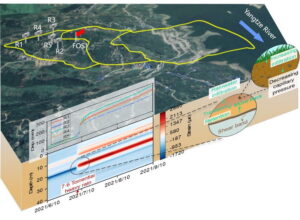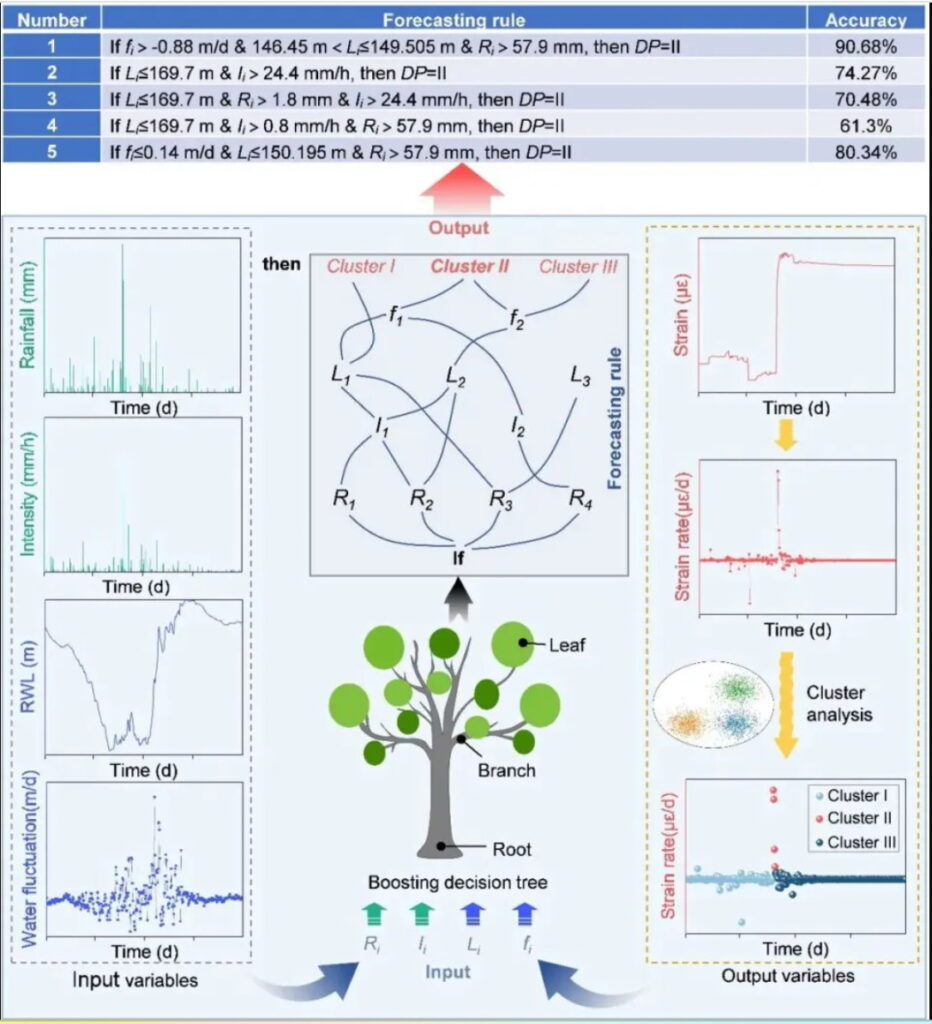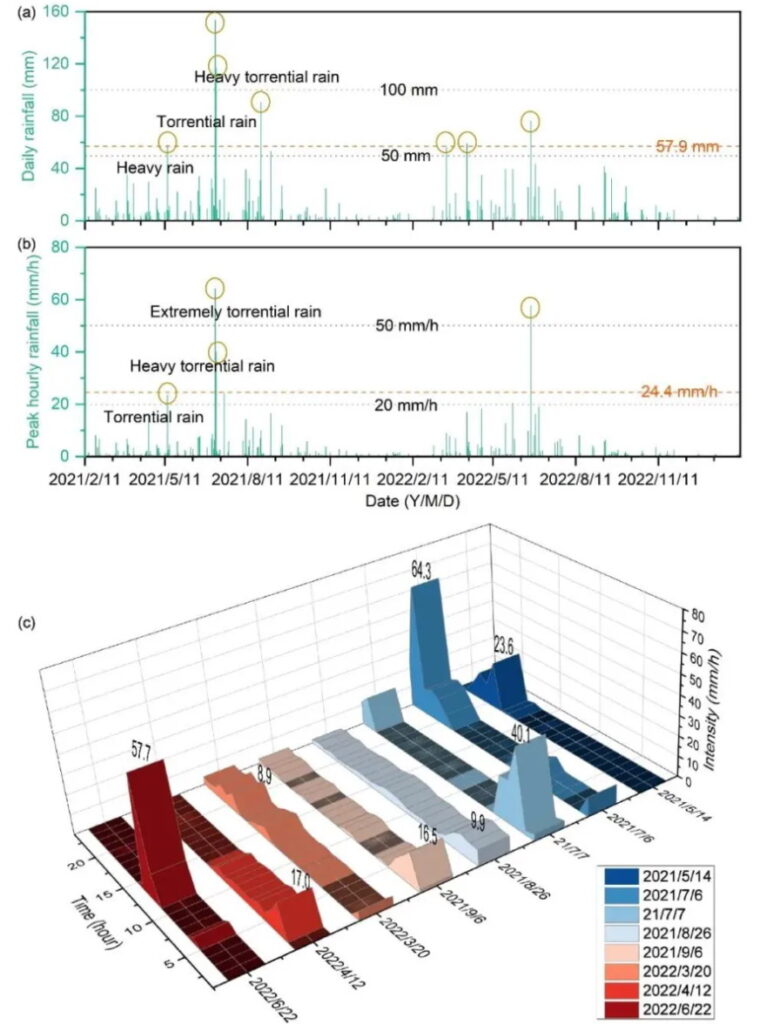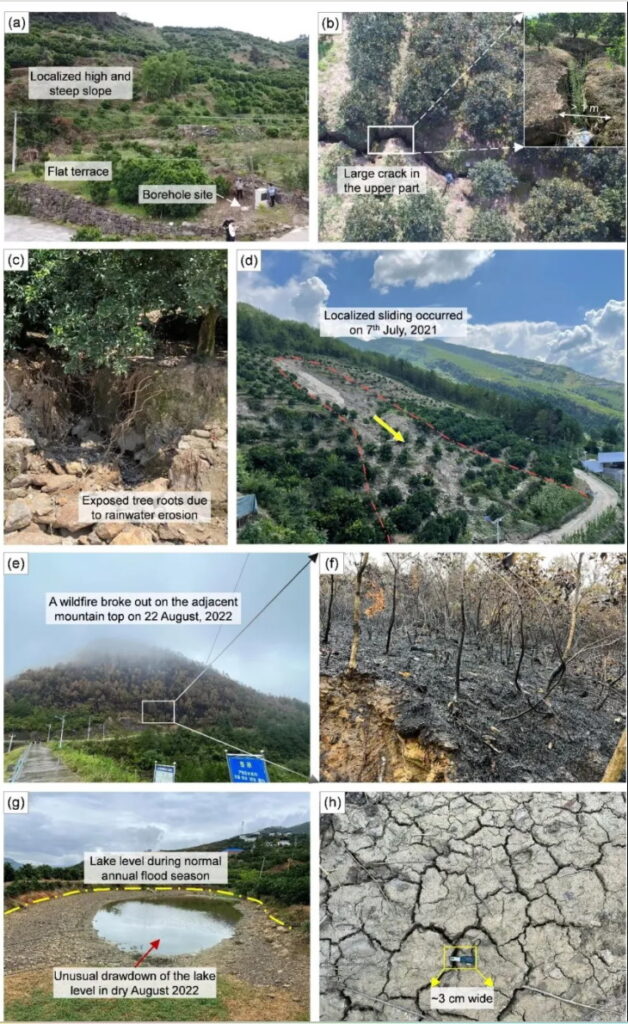【研究意义】
随着水电工程的大规模建设与运行,以及极端气候事件的频繁发生,大量的库岸斜坡发生缓慢移动甚至局部崩塌,库区滑坡的风险逐渐增加。然而,对这类滑坡的运动学特征和驱动因素的认识仍非常有限。尽管缓慢移动的水库滑坡直接引起大量人员伤亡的事件相对少见,但一旦其活动模式转变为快速滑动,则可能威胁重大基础设施和社区安全,对人居环境和区域可持续发展带来不利影响。缓慢移动滑坡提供了天然的实验室,通过长期原位观测,能够揭示其演化特征和触发机理,为滑坡预测预警和风险管理提供重要的数据基础。
在库区滑坡地质灾害管理中,实施多因子协同预警对提升响应效率和减灾能力具有重要意义。尽管基于地表位移的滑坡预测预警已经被广泛研究,但是地下实时观测数据的缺乏限制了我们对触发滑坡加速变形的临界条件准确预测的能力。
【研究内容】
本研究中,南京大学联合意大利国家研究委员会地质水文保护研究所(National Research Council-Research Institute for Geo-HydrologicalProtection, CNR-IRPI)和帕多瓦大学(University of Padova),分析了一个具有数十年监测历史的缓慢移动特大型滑坡案例——藕塘滑坡,利用高时空分辨率的光纤神经系统(Fiber Optic Nerve System, FONS),获取了自2021年2月起一个完整水文年的地下应变数据。前期研究显示,短时高强降雨是滑坡加速运动的主要驱动因素。考虑到滑坡变形的时滞效应,本研究采用数据驱动的方法,重新检查和量化了加速运动的潜在控制因素,揭示了滑坡变形对极端降雨的即时响应。为明确滑坡加速变形的临界水文气象条件,本研究基于地下应变数据和增强决策树算法开发了一个预测模型,综合考虑了降雨和库水位的影响。模型融合了日降雨量、降雨强度、库水位高程、水位波动和滑带应变时间序列数据,并根据滑带应变特征,将其聚类为近稳态、加速变形和稳态三种。研究结果显示,滑坡加速变形最有可能在中低水位(即水位高程低于169.7 m)且伴有大量降雨或高强度降雨(即日降雨量超过57.9 mm或降雨强度超过24.4 mm/h)的情况下发生。这种多因子协同预警策略极大地缩短了地质灾害风险管理的时间窗口,为相关决策部门提供了快速风险评估和应急响应的能力。

图1 GNSS地表位移时间序列与FOS地下应变时空剖面
通过多次野外调研,研究人员验证了所提出的水文气象预警准则的有效性。在2021年的极端降水条件下,短时高强降雨触发了显著的滑坡运动,而在2022年的极端干旱条件下,滑坡的整体变形则明显减小。本研究旨在针对近年极端水文气象事件的增加,为特大型库区滑坡灾害管理提供一个实用的早期预警和应急管理框架。未来研究将考虑联系地下热-水-力相互作用的本质,通过纳入滑带土体温度和含水量数据以进一步优化预测模型,提升滑坡早期预警的准确性和有效性。

图2 基于滑带应变的增强决策树模型与多因子协同预警策略

图3 极端降水/干旱水文年可能触发滑坡加速运动的降雨事件特征

图4 现场监测结果及其同期水文气象记录
 图5 揭示滑坡运动学特征和验证早期预警准则的现场证据
图5 揭示滑坡运动学特征和验证早期预警准则的现场证据
Towards hydrometeorological thresholds of reservoir-induced landslide from subsurface strain observations
YE Xiao 1,2, ZHU HongHu 1*, WANG Jia 1, ZHENG WanJi 3, ZHANG Wei 1*, SCHENATO Luca 4, PASUTO Alessandro 5, CATANI Filippo 2
1 School of Earth Sciences and Engineering, Nanjing University, Nanjing 210023, China;
2 Department of Geosciences, University of Padova, Padova 35131, Italy;
3 School of Geosciences and Info-Physics, Central South University, Changsha 410083, China;
4 Department of Information Engineering, University of Padova, Padova 35131, Italy;
5 National Research Council-Research Institute for Geo-Hydrological Protection (CNR-IRPI), Padova 35127, Italy
*Corresponding authors (emails: zhh@nju.edu.cn; wzhang@nju.edu.cn)
Abstract: Synergistic multi-factor early warning of large-scale landslides is a crucial component of geohazard prevention and mitigation efforts in reservoir areas. Landslide forecasting and early warning based on surface displacements have been widely investigated. However, the lack of direct subsurface real-time observations limits our ability to predict critical hydrometeorological conditions that trigger landslide acceleration. In this paper, we leverage subsurface strain data measured by high-resolution fiber optic sensing nerves that were installed in a giant reservoir landslide in the Three Gorges Reservoir (TGR) region, China, spanning a whole hydrologic year since February 2021. The spatiotemporal strain profile has preliminarily identified the slip zones and potential drivers, indicating that high-intensity short-duration rainstorms controlled the landslide kinematics from an observation perspective. Considering the time lag effect, we reexamined and quantified potential controls of accelerated movements using a data-driven approach, which reveals immediate response of landslide deformation to extreme rainfall with a zero-day shift. To identify critical hydrometeorological rules in accelerated movements, accounting for the dual effect of rainfall and reservoir water level variations, we thus construct a landslide prediction model that relies upon the boosting decision tree (BDT) algorithm using a dataset comprising daily rainfall, rainfall intensity, reservoir water level, water level fluctuations, and slip zone strain time series. The results indicate that landslide acceleration is most likely to occur under the conditions of mid-low water levels (i.e., < 169.700 m) and large-amount and high-intensity rainfalls (i.e., daily rainfall > 57.9 mm and rainfall intensity > 24.4 mm/h). Moreover, this prediction model allows us to update hydrometeorological thresholds by incorporating the latest monitoring dataset. Standing on the shoulder of this landslide case, our study informs a practical and reliable pathway for georisk early warning based on subsurface observations, particularly in the context of enhanced extreme weather events.
Keywords: slow-moving landslide, fiber-optic monitoring, subsurface strain, hydrometeorological threshold, extreme weather
